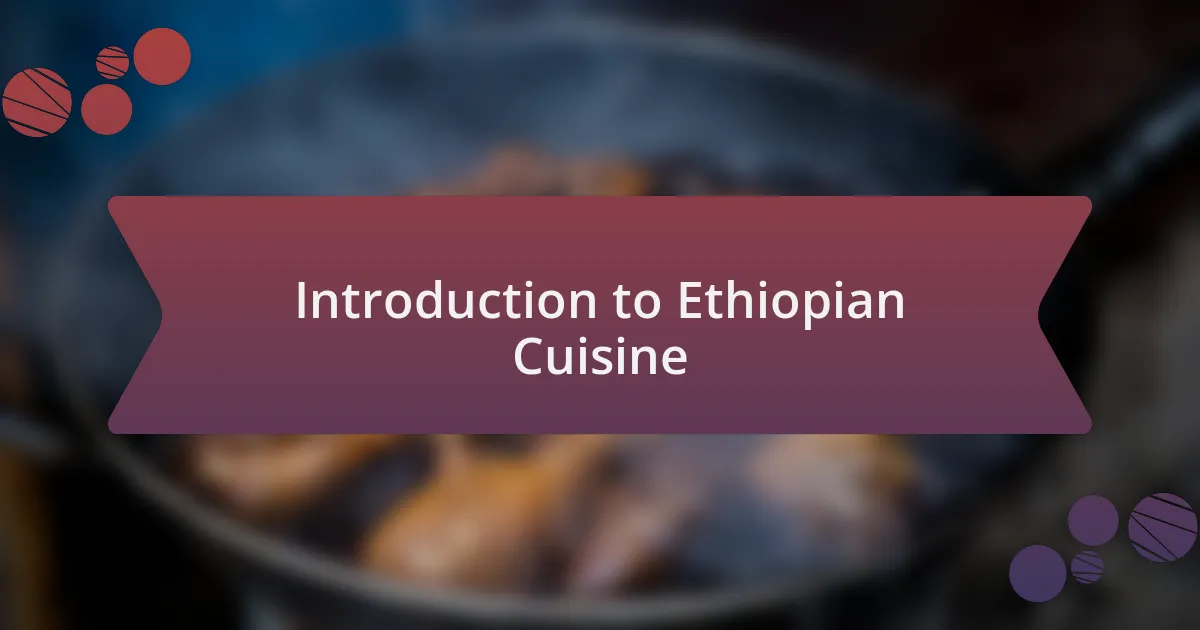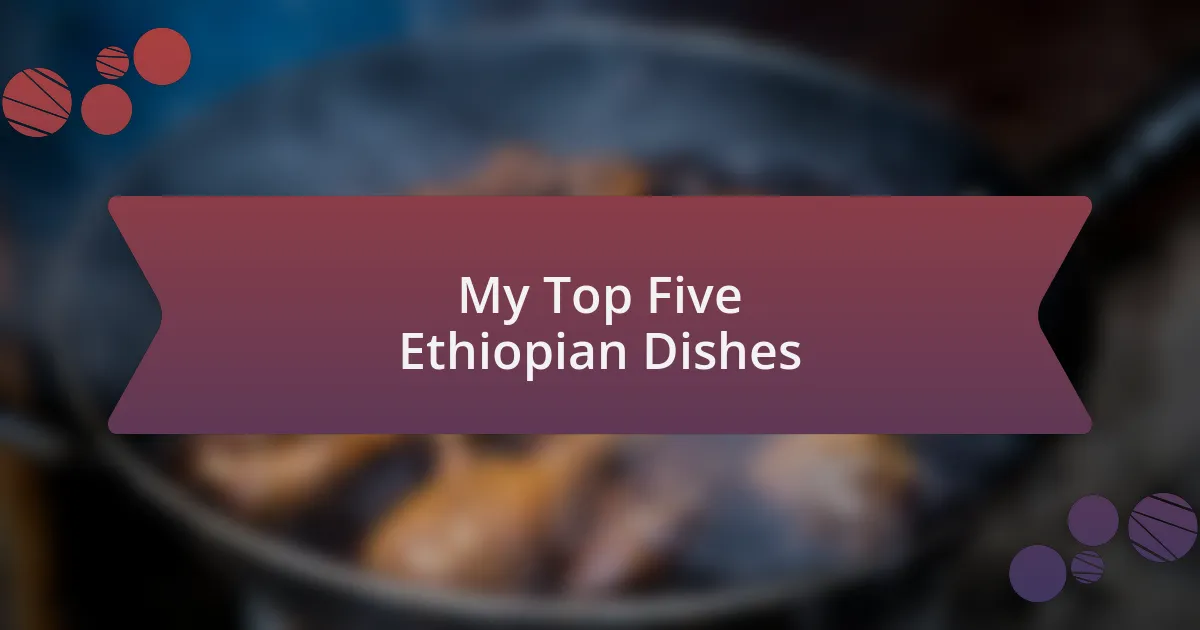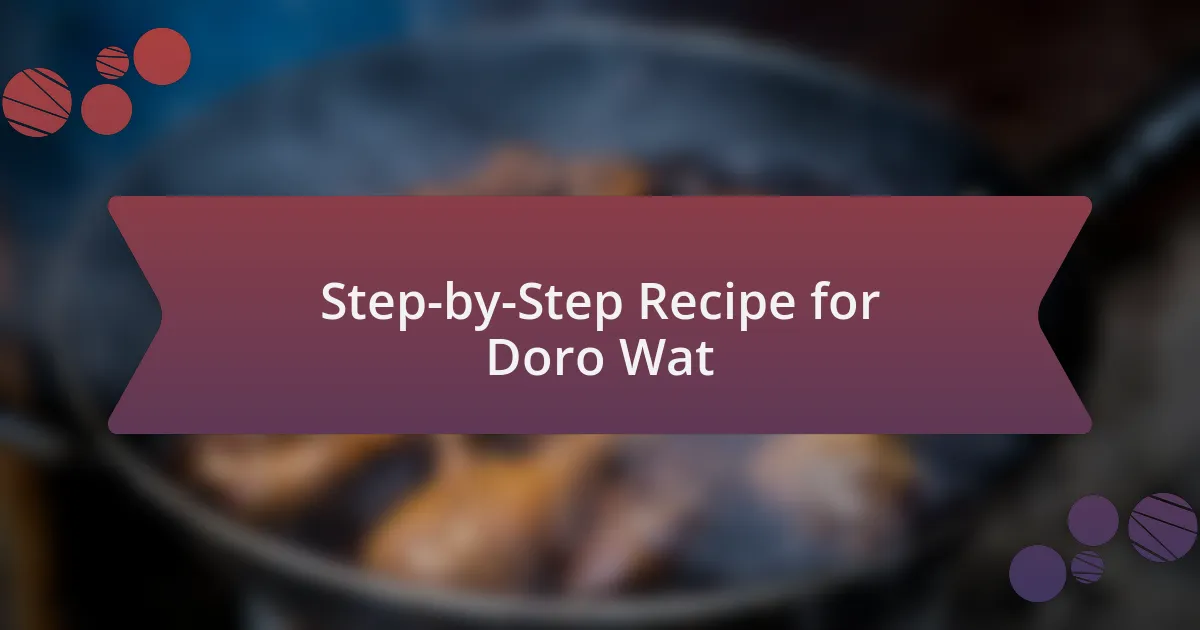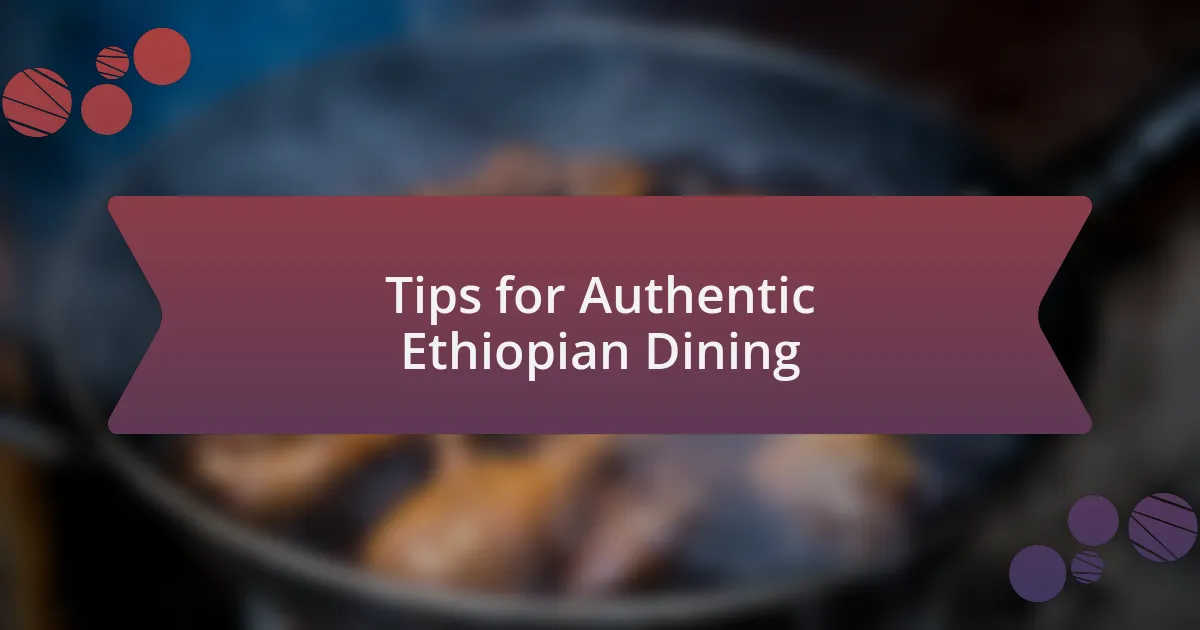Key takeaways:
- Ethiopian cuisine is defined by communal dining, unique ingredients, and spices like berbere, enriching flavors and cultural connections.
- The staple ingredient teff flour is essential for injera, while niter kibbeh adds depth to many dishes.
- Popular cooking techniques include steaming, sautéing with niter kibbeh, and fermentation, each enhancing the dining experience.
- Authentic Ethiopian meals emphasize shared experiences, eating with the right hand, and the importance of storytelling around the table.

Introduction to Ethiopian Cuisine
Ethiopian cuisine is a vibrant and diverse tapestry of flavors, characterized by its unique ingredients and communal dining style. I remember my first experience enjoying a traditional Ethiopian meal, where we shared a large platter of injera topped with various stews, each vividly colored and bursting with spices. The feeling of dipping into shared dishes with my hands created an atmosphere of connection and warmth that I hadn’t experienced before.
One of the defining elements of Ethiopian food is its use of spices, particularly berbere, a blend that imparts deep, complex flavors. Have you ever tried a dish where the first bite transports you straight to another culture? That’s exactly how I felt when I savored doro wat – a spicy chicken stew that incorporates this amazing mix. It’s fascinating how a single spice blend can tell stories of land, history, and tradition through each bite.
Then there’s injera itself, a sourdough flatbread that not only serves as a base for the meal but also doubles as the utensil. Its texture and tanginess add an entirely new dimension to the dining experience, and I find myself craving it long after the meal is over. Have you ever found a dish that resonates with you so deeply it lingers in your thoughts? For me, Ethiopian cuisine is more than food; it’s an invitation to explore and embrace a rich culture.

Essential Ingredients for Ethiopian Cooking
When it comes to Ethiopian cooking, one ingredient that stands out is teff flour, the staple grain used to make injera. I remember the first time I ground teff beans, the nutty aroma filled my kitchen, and I couldn’t help but feel a connection to the generations before me who did the same. Have you ever worked with a grain that not only nourishes but also weaves culture into the dish?
Another essential ingredient is the berbere spice blend, a delightful medley of spices including chili peppers, garlic, and ginger. I often find myself reaching for it whenever I need a burst of flavor in my dishes; it instantly transports me to the heart of Ethiopia. Can you relate to how a specific combination of spices can elevate an everyday meal to something extraordinary, leaving you yearning for more?
Don’t overlook niter kibbeh, a spiced clarified butter that enriches many recipes. The first time I simmered it with various spices, I was amazed by how it deepened the flavors of the vegetables and meats I was cooking. Have you ever encountered a cooking fat that added not just richness but a soulful component to your dishes? It’s these little ingredients that make Ethiopian cuisine so distinctive and heartwarming.

Popular Ethiopian Cooking Techniques
When exploring Ethiopian cooking techniques, steaming is a popular method that brings out the natural flavors of the ingredients while keeping them moist. I remember my first attempt at making doro wat, a spicy chicken stew, where I used a traditional steamer. The aroma wafting through my kitchen was intoxicating, and I couldn’t wait to see how the dish transformed with this technique. Have you ever experienced how the right cooking method can elevate a dish from good to unforgettable?
Another essential technique is sautéing, particularly when infusing niter kibbeh into vegetables or meats. The moment I sautéed onions until they turned golden brown and sweet, I felt that familiar rush of excitement. It’s a simple act that adds layers of flavor and richness. Doesn’t it feel like magic when a basic ingredient can create such a delightful contrast in taste?
Fermentation is also a key technique in Ethiopian cuisine, particularly in making injera. When I first attempted to ferment the teff flour batter, I was amazed by how time and patience transformed it into this tangy, spongy flatbread. It reminded me that great dishes often require more than just skill; they also need a touch of time and love. Have you found that some techniques require a leap of faith that ultimately pays off in delicious rewards?

My Top Five Ethiopian Dishes
When it comes to my top five Ethiopian dishes, doro wat is undeniably at the top of the list. This spicy chicken stew is a symphony of flavors, and every time I make it, I feel like I’m conducting a grand orchestra in my kitchen. The rich sauce, laden with niter kibbeh and berbere spice, creates a cozy warmth that wraps around you like a hug. Have you ever had a dish that felt so personal?
Next up is kitfo, which is raw minced beef seasoned with spices and clarified butter. I will never forget the first time I dared to try it; the vibrant flavors just danced on my palate in a way I never anticipated. It’s an experience that challenges the norm and opens your eyes to the beauty of simplicity. Doesn’t stepping out of our comfort zones lead to the most memorable culinary experiences?
Finally, I can’t leave out shiro, a chickpea stew that’s both comforting and hearty. Whenever I prepare it, the aroma alone transports me to a bustling Ethiopian eatery, where every bite tells a deep story of tradition and culture. The creamy texture and spices perfectly illustrate how basic ingredients elevate a meal to something truly special. Have you explored how soul-nourishing dishes can connect us to our past?

Step-by-Step Recipe for Doro Wat
To create a memorable Doro Wat, start by marinating chicken pieces in lemon juice, garlic, and a generous helping of berbere spice. I remember the first time I combined these ingredients; the vibrant aroma filled my kitchen and I couldn’t help but feel excited for the meal ahead. Don’t skimp on the marinating time; letting the chicken soak up those spices overnight makes a world of difference.
Once your chicken is well-marinated, it’s time to sauté finely chopped onions in niter kibbeh until they turn golden brown. This step is where the magic begins! I’ll never forget how, during one cooking session, the sautéing onions filled my home with an irresistible smell that made my neighbors curious enough to stop by for a taste. That’s the kind of aroma that draws people in—don’t you think food has a special way of fostering connection?
Finally, add the marinated chicken to the pot and cover it to simmer, allowing the flavors to meld together beautifully. As the Doro Wat cooks down and thickens, you’ll want to check on it occasionally, stirring gently. I often find myself daydreaming about sharing this dish with friends during special gatherings, relishing in the community vibe that great food brings. Have you ever noticed how certain dishes can spark conversation and create lasting memories?

Tips for Authentic Ethiopian Dining
When preparing for an authentic Ethiopian meal, consider using injera as your base. This traditional sourdough flatbread isn’t just a food; it’s a vital part of the dining experience. I remember the first time I saw injera served on a communal platter, filled with colorful dishes and surrounded by friends ready to dig in. There’s something incredibly inviting about sharing food directly from the same plate—have you ever felt that sense of togetherness when enjoying a meal with others?
Another key aspect of Ethiopian dining is the way food is served and enjoyed. Generally, you eat with your right hand, which I found to be a surprisingly intimate experience. I was initially hesitant, but I quickly discovered how much it added to the enjoyment as I scooped up bites of Doro Wat and vegetables with injera, fully embracing the tradition. It truly transforms your interaction with the meal; don’t you think that engaging with food in this hands-on manner heightens your appreciation for it?
Lastly, don’t forget the importance of sharing stories and laughter around the table. In my experience, meals infused with conversation feel richer and more enjoyable. I recall evenings where, after devouring a delicious spread, we’d sit back and reflect on our day. It was a reminder that Ethiopian dining is not just about the food itself, but the connections we build and the memories we create while sharing it. Isn’t that what makes dining truly special?